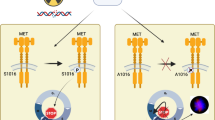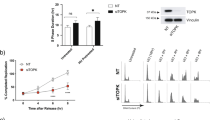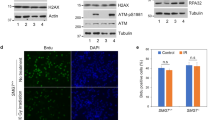Abstract
G2/M checkpoint activation after DNA damage results in G2/M cell cycle arrest that allows time for DNA repair before the entry of cells into mitosis. Activation of G2/M checkpoint involves a series of signaling events, which include activation of ataxia telangiectecia-mutated and Rad3-related (ATR) and Chk1 kinases and inhibition of Cdc2/Cyclin B activity. Studies presented in this report show that serine (Ser)/threonine (Thr) protein phosphatase 2A (PP2A) has an important role in G2/M checkpoint activation in response to γ-irradiation (IR) exposure. Using PP2A inhibitors, as well as siRNA targeting various forms of Ser/Thr protein phosphatases, results presented in this report show that specific PP2A inhibition abrogates IR-induced activation of ATR and Chk1 kinases, as well as phosphorylation of Cdc2-Tyr15, and attenuates IR-induced G2/M arrest. These results suggest an important regulation of PP2A on IR-induced G2/M checkpoint signaling response.
This is a preview of subscription content, access via your institution
Access options
Subscribe to this journal
Receive 50 print issues and online access
$259.00 per year
only $5.18 per issue
Buy this article
- Purchase on Springer Link
- Instant access to full article PDF
Prices may be subject to local taxes which are calculated during checkout




Similar content being viewed by others
References
Ahn JY, Schwarz JK, Piwnica-Worms H, Canman CE . (2000). Threonine 68 phosphorylation by ataxia telangiectasia mutated is required for efficient activation of Chk2 in response to ionizing radiation. Cancer Res 60: 5934–5936.
Ambach A, Saunus J, Konstandin M, Wesselborg S, Meuer SC, Samstag Y . (2000). The serine phosphatases PP1 and PP2A associate with and activate the actin-binding protein cofilin in human T lymphocytes. Eur J Immunol 30: 3422–3431.
Atherton-Fessler S, Parker LL, Geahlen RL, Piwnica-Worms H . (1993). Mechanisms of p34cdc2 regulation. Mol Cell Biol 13: 1675–1685.
Chen Y, Sanchez Y . (2004). Chk1 in the DNA damage response: conserved roles from yeasts to mammals. DNA Repair (Amst) 3: 1025–1032.
Cho US, Morrone S, Sablina AA, Arroyo JD, Hahn WC, Xu W . (2007). Structural basis of PP2A inhibition by small t antigen. PLoS Biol 5: e202.
Chowdhury D, Keogh M-C, Ishii H, Peterson CL, Buratowski S, Lieberman J . (2005). [gamma]-H2AX Dephosphorylation by protein phosphatase 2A facilitates DNA Double-strand break repair. Molecular Cell 20: 801.
Cohen P . (1991). Classification of protein-serine/threonine phosphatases: identification and quantitation in cell extracts. Methods Enzymol 201: 389–398.
Cohen P . (1992). Signal integration at the level of protein kinases, protein phosphatases and their substrates. Trends Biochem Sci 17: 408–413.
Cohen P, Klumpp S, Schelling DL . (1989). An improved procedure for identifying and quantitating protein phosphatases in mammalian tissues. FEBS Lett 250: 596–600.
Cohen PTW . (2002). Protein phosphatase 1—targeted in many directions. J Cell Sci 115: 241–256.
Essmann F, Engels IH, Totzke G, Schulze-Osthoff K, Janicke RU . (2004). Apoptosis resistance of MCF-7 breast carcinoma cells to ionizing radiation is independent of p53 and cell cycle control but caused by the lack of caspase-3 and a caffeine-inhibitable event. Cancer Res 64: 7065–7072.
Favre B, Turowski P, Hemmings BA . (1997). Differential inhibition and posttranslational modification of protein phosphatase 1 and 2A in MCF7 cells treated with calyculin-A, okadaic acid, and tautomycin. J Biol Chem 272: 13856–13863.
Goodarzi AA, Jonnalagadda JC, Douglas P, Young D, Ye R, Moorhead GB et al. (2004). Autophosphorylation of ataxia-telangiectasia mutated is regulated by protein phosphatase 2A. Embo J 23: 4451–4461.
Hall-Jackson CA, Cross DA, Morrice N, Smythe C . (1999). ATR is a caffeine-sensitive, DNA-activated protein kinase with a substrate specificity distinct from DNA-PK. Oncogene 18: 6707–6713.
Iliakis G, Wang Y, Guan J, Wang H . (2003). DNA damage checkpoint control in cells exposed to ionizing radiation. Oncogene 22: 5834–5847.
Jang Y-J, Ji J-H, Choi Y-C, Ryu CJ, Ko S-Y . (2007). Regulation of polo-like kinase 1 by DNA damage in mitosis: inhibition of mitotic plk-1 by protein phosphatase 2A. J Biol Chem' 282: 2473–2482.
Janssens V, Goris J . (2001). Protein phosphatase 2A: a highly regulated family of serine/threonine phosphatases implicated in cell growth and signalling. Biochem J 353: 417–439.
Janssens V, Goris J, Van Hoof C . (2005). PP2A: the expected tumor suppressor. Current Opinion in Genetics & Development 15: 34.
Janssens V, Longin S, Goris J . (2008). PP2A holoenzyme assembly: in cauda venenum (the sting is in the tail). Trends Biochem Sci 33: 113.
Jin P, Gu Y, Morgan DO . (1996). Role of inhibitory CDC2 phosphorylation in radiation-induced G2 arrest in human cells. J Cell Biol 134: 963–970.
Kastan MB, Bartek J . (2004). Cell-cycle checkpoints and cancer. Nature 432: 316–323.
Lee KM, Yasuda H, Hollingsworth MA, Ouellette MM . (2005). Notch 2-positive progenitors with the intrinsic ability to give rise to pancreatic ductal cells. Lab Invest 85: 1003–1012.
Leung-Pineda V, Ryan CE, Piwnica-Worms H . (2006). Phosphorylation of Chk1 by ATR Is Antagonized by a Chk1-Regulated Protein Phosphatase 2A Circuit. Mol Cell Biol 26: 7529–7538.
Li G, Elder RT, Qin K, Park HU, Liang D, Zhao RY . (2007a). Phosphatase Type 2A-dependent and -independent Pathways for ATR Phosphorylation of Chk1. J Biol Chem 282: 7287–7298.
Li HH, Cai X, Shouse GP, Piluso LG, Liu X . (2007b). A specific PP2A regulatory subunit, B56gamma, mediates DNA damage-induced dephosphorylation of p53 at Thr55. Embo J 26: 402–411.
Li HH, Li AG, Sheppard HM, Liu X . (2004). Phosphorylation on Thr-55 by TAF1 mediates degradation of p53: a role for TAF1 in cell G1 progression. Mol Cell 13: 867–878.
Liu Q, Guntuku S, Cui XS, Matsuoka S, Cortez D, Tamai K et al. (2000). Chk1 is an essential kinase that is regulated by Atr and required for the G(2)/M DNA damage checkpoint. Genes Dev 14: 1448–1459.
Liu X, Kim CN, Yang J, Jemmerson R, Wang X . (1996). Induction of apoptotic program in cell-free extracts: requirement for dATP and cytochrome c. Cell 86: 147–157.
Matsuoka S, Rotman G, Ogawa A, Shiloh Y, Tamai K, Elledge SJ . (2000). Ataxia telangiectasia-mutated phosphorylates Chk2 in vivo and in vitro. Proc Natl Acad Sci USA 97: 10389–10394.
Mayer-Jaekel RE, Hemmings BA . (1994). Protein phosphatase 2A—a ′menage a trois′. Trends Cell Biol 4: 287–291.
McConnell JL, Wadzinski BE . (2009). Targeting protein serine/threonine phosphatases for drug development. Mol Pharmacol 75: 1249–1261.
Nagasawa H, Keng P, Maki C, Yu Y, Little JB . (1998). Absence of a radiation-induced first-cycle G1-S arrest in p53+ human tumor cells synchronized by mitotic selection. Cancer Res 58: 2036–2041.
O'Connell MJ, Cimprich KA . (2005). G2 damage checkpoints: what is the turn-on? J Cell Sci 118: 1–6.
Pallas DC, Shahrik LK, Martin BL, Jaspers S, Miller TB, Brautigan DL et al. (1990). Polyoma small and middle T antigens and SV40 small t antigen form stable complexes with protein phosphatase 2A. Cell 60: 167–176.
Pankov R, Cukierman E, Clark K, Matsumoto K, Hahn C, Poulin B et al. (2003). Specific beta1 integrin site selectively regulates Akt/protein kinase B signaling via local activation of protein phosphatase 2A. J Biol Chem 278: 18671–18681.
Reinhardt HC, Yaffe MB . (2009). Kinases that control the cell cycle in response to DNA damage: Chk1, Chk2, and MK2. Current Opinion in Cell Biology 21: 245–255.
Sancar A, Lindsey-Boltz LA, Unsal-Kacmaz K, Linn S . (2004). Molecular mechanisms of mammalian DNA repair and the DNA damage checkpoints. Annu Rev Biochem 73: 39–85.
Sarkaria JN, Busby EC, Tibbetts RS, Roos P, Taya Y, Karnitz LM et al. (1999). Inhibition of ATM and ATR kinase activities by the radiosensitizing agent, caffeine. Cancer Res 59: 4375–4382.
Smits VA, Medema RH . (2001). Checking out the G(2)/M transition. Biochim Biophys Acta 1519: 1–12.
Sontag E, Fedorov S, Kamibayashi C, Robbins D, Cobb M, Mumby M . (1993). The interaction of SV40 small tumor antigen with protein phosphatase 2A stimulates the map kinase pathway and induces cell proliferation. Cell 75: 887–897.
Strack S, Cribbs JT, Gomez L . (2004). Critical Role for Protein Phosphatase 2A Heterotrimers in Mammalian Cell Survival. Journal of Biological Chemistry 279: 47732–47739.
Swingle M, Ni L, Honkanen RE . (2007). Small-molecule inhibitors of ser/thr protein phosphatases: specificity, use and common forms of abuse. Methods Mol Biol 365: 23–38.
Takai A, Sasaki K, Nagai H, Mieskes G, Isobe M, Isono K et al. (1995). Inhibition of specific binding of okadaic acid to protein phosphatase 2A by microcystin-LR, calyculin-A and tautomycin: method of analysis of interactions of tight-binding ligands with target protein. Biochem J 306 (Pt 3): 657–665.
Xu B, Kastan MB . (2004). Analyzing cell cycle checkpoints after ionizing radiation. Methods Mol Biol 281: 283–292.
Xu B, Kim S, Kastan MB . (2001). Involvement of Brca1 in S-phase and G(2)-phase checkpoints after ionizing irradiation. Mol Cell Biol 21: 3445–3450.
Yan Y, Black CP, Cowan KH . (2007). Irradiation-induced G2/M checkpoint response requires ERK1/2 activation. Oncogene 26: 4689–4698.
Yan Y, Mumby MC . (1999). Distinct roles for PP1 and PP2A in phosphorylation of the retinoblastoma protein. PP2a regulates the activities of G(1) cyclin-dependent kinases. J Biol Chem 274: 31917–31924.
Yan Y, Spieker RS, Kim M, Stoeger SM, Cowan KH . (2005). BRCA1-mediated G2/M cell cycle arrest requires ERK1/2 kinase activation. Oncogene 24: 3285–3296.
Zhao H, Piwnica-Worms H . (2001). ATR-mediated checkpoint pathways regulate phosphorylation and activation of human Chk1. Mol Cell Biol 21: 4129–4139.
Acknowledgements
We thank Dr Michel Ouellette for providing HPNE cells, Dr Helen Piwnica Worms for GST-Cdc25C construct, Dr Charles Kuzynski, Victoria Smith and Megan Michalak for assistance on the flow cytometry analysis, and Dr Janina Baranowska-Kortylewicz for assistance on the operation of Mark I 68A Cesium-137 Irradiator. This work was supported by Nebraska DHHS-LB506 grant 2007-45 to YY, NCI Training Grant (NCI T32 CA009476) to RK and NCI Cancer Center Support Grant (P30CA036727) to KC.
Author information
Authors and Affiliations
Corresponding author
Ethics declarations
Competing interests
The authors declare no conflict of interest.
Additional information
Supplementary Information accompanies the paper on the Oncogene website
Supplementary information
Rights and permissions
About this article
Cite this article
Yan, Y., Cao, P., Greer, P. et al. Protein phosphatase 2A has an essential role in the activation of γ-irradiation-induced G2/M checkpoint response. Oncogene 29, 4317–4329 (2010). https://doi.org/10.1038/onc.2010.187
Received:
Revised:
Accepted:
Published:
Issue Date:
DOI: https://doi.org/10.1038/onc.2010.187
Keywords
This article is cited by
-
ATM phosphorylates PP2A subunit A resulting in nuclear export and spatiotemporal regulation of the DNA damage response
Cellular and Molecular Life Sciences (2022)
-
PP2A and tumor radiotherapy
Hereditas (2020)
-
PR55α regulatory subunit of PP2A inhibits the MOB1/LATS cascade and activates YAP in pancreatic cancer cells
Oncogenesis (2019)
-
miR-19b enhances proliferation and apoptosis resistance via the EGFR signaling pathway by targeting PP2A and BIM in non-small cell lung cancer
Molecular Cancer (2018)
-
HDAC1 and HDAC2 integrate checkpoint kinase phosphorylation and cell fate through the phosphatase-2A subunit PR130
Nature Communications (2018)



